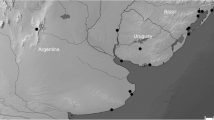Abstract
Males of the brush-legged wolf spider, Schizocosa ocreata (Araneae: Lycosidae), possess a conspicuous male secondary sexual character: dark pigmentation and tufts of bristles on the tibiae of their forelegs. We tested several hypotheses relating to the role of this conspicuous trait in sexual selection. Triad mating experiments suggest that the tufts do not play an obvious role in the operation of sexual selection by either male competition or female choice, as there were no significant differences in the mating success of intact and experimentally shaved males. However, females mated more often with males that initiated courtship first, suggesting that capture of a female’s attention by male signalling may play a critical role. In behavioral experiments that paired a single male with a female in arenas that allowed both visual and vibratory signal transmission during courtship, female receptivity did not vary significantly with the presence or absence of tufts. However, experiments that isolated the visual component of communication (by eliminating vibratory communication) revealed a significant effect of the presence of tufts: females showed receptivity less often to males with tufts removed. Female response to visual signals was much greater in S. ocreata than in its sibling congener, Schizocosa rovneri, which lacks male tufts. We hypothesize that the tufts serve to increase the efficacy of visual displays of S. ocreata, as vibratory communication is constrained by the complex leaf litter habitat of some populations. Such environmental constraints may make visual signalling over distance a critical factor for effective courtship communication, which may in turn strongly influence male fitness.
Similar content being viewed by others
Author information
Authors and Affiliations
Additional information
Received: 30 September 1994/Accepted after revision: 4 August 1995
Rights and permissions
About this article
Cite this article
Scheffer, S., Uetz, G. & Stratton, G. Sexual selection, male morphology, and the efficacy of courtship signalling in two wolf spiders (Araneae: Lycosidae). Behav Ecol Sociobiol 38, 17–23 (1996). https://doi.org/10.1007/s002650050212
Issue Date:
DOI: https://doi.org/10.1007/s002650050212




